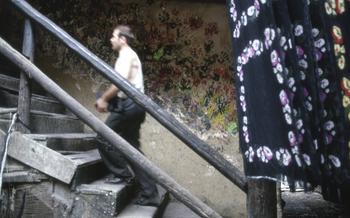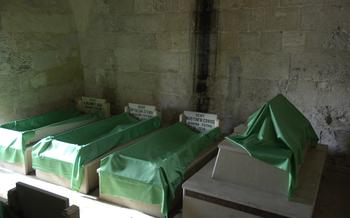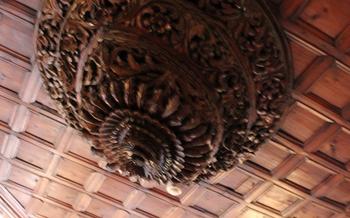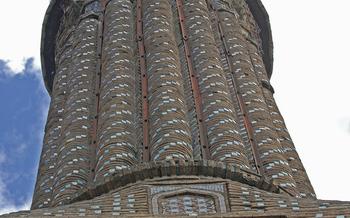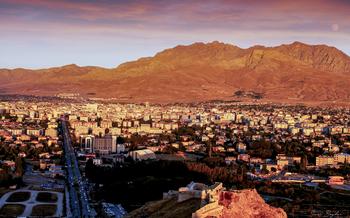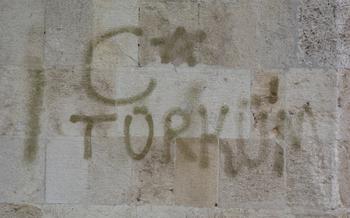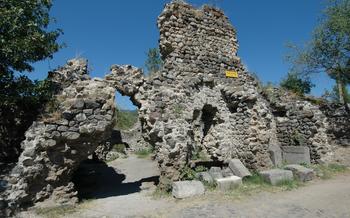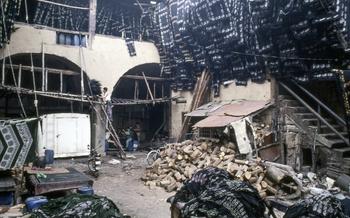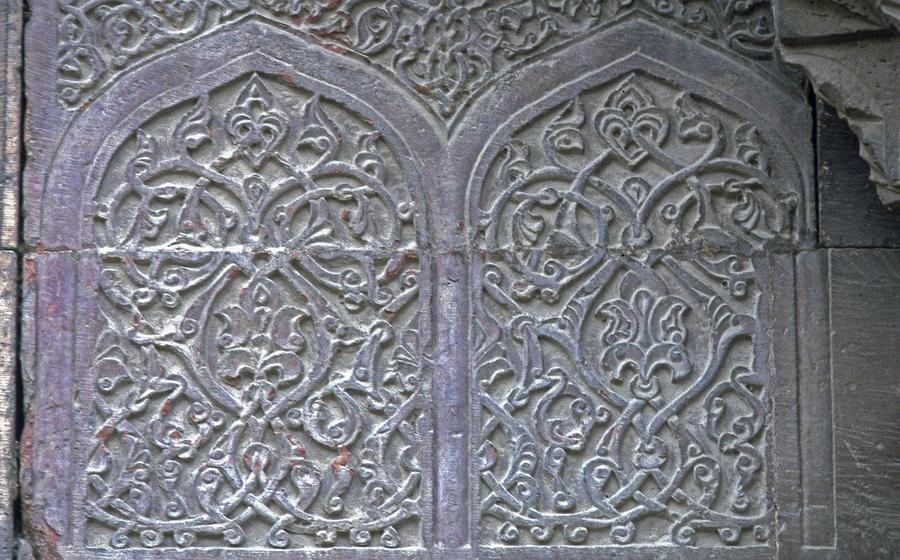
Gök Medrese
- Historical Significance
- Architectural Masterpiece
- Educational Legacy
- Cultural Impact
- Preservation Efforts
- Things to Do
- Photography Tips
- Getting There
- Where to Stay
- Where to Eat
- What to Buy
Historical Significance
The Gök Medrese, with its rich history and architectural heritage, stands as a testament to the Seljuk dynasty's influence on the region. Founded in the 13th century, this Islamic educational institution played a pivotal role in shaping the intellectual and religious landscape of Tokat. Explore the stories behind its construction and restoration over the centuries, uncovering the legacy of famous scholars and students associated with this esteemed medrese. Admire the well-preserved inscriptions and decorative elements that adorn the building, offering glimpses into its past grandeur. Immerse yourself in the history of the Gök Medrese and discover the enduring impact of Seljuk architecture and Islamic education on this vibrant city.
Architectural Masterpiece
The Gök Medrese stands as a testament to the architectural brilliance of the Seljuk dynasty. Its construction showcases a harmonious blend of Seljuk and Anatolian architectural styles, creating a unique and captivating structure. The medrese's exterior features intricate stone carvings, glazed tiles, and decorative brickwork that adorn its walls and portal. Step inside the central courtyard, and you'll be greeted by a serene and spacious area surrounded by arched niches and elegant columns. Explore the lecture halls, each adorned with arched niches and decorative mihrabs, where students once gathered to learn and debate. Finally, don't miss the student cells, where students lived and studied, featuring simple yet functional living quarters that offer a glimpse into their daily lives.
Educational Legacy
The Gök Medrese, renowned for its architectural splendor, also holds a significant place in the annals of Islamic education. As a center of learning, it played a pivotal role in shaping the intellectual and religious landscape of the region. Within its walls, students from various backgrounds sought knowledge and enlightenment.
The curriculum at the Gök Medrese encompassed a wide range of subjects, including theology, law, philosophy, and the natural sciences. Renowned scholars and teachers imparted their wisdom to eager students, who came from far and wide to study under their tutelage. Among the notable scholars who graced the medrese's halls were the renowned theologian and philosopher Imam Ghazali and the eminent jurist Abu Yusuf.
The medrese's educational legacy extends beyond the mere dissemination of knowledge. It served as a hub for intellectual discourse and debate, where scholars engaged in lively exchanges of ideas and perspectives. This vibrant intellectual atmosphere fostered a spirit of inquiry and critical thinking, which had a profound impact on the development of Islamic thought and scholarship.
Cultural Impact
Beyond its educational role, the Gök Medrese played a significant cultural role in the Tokat community. It served as a community center, where people from all walks of life gathered for various social and religious events. The medrese hosted festivals and celebrations, such as religious holidays and weddings, which brought the community together and fostered a sense of belonging. Furthermore, the medrese was a place of worship, with a dedicated prayer hall where students and community members performed their daily prayers. The cultural significance of the Gök Medrese extended beyond its walls, influencing local traditions, customs, and folklore. The medrese's teachings and practices shaped the moral and ethical values of the community, contributing to the region's rich cultural heritage.
Preservation Efforts
Protecting the Gök Medrese as a valuable historical monument is of utmost importance. Extensive restoration and conservation projects have been undertaken to safeguard its architectural integrity and preserve its historical significance for future generations. These projects involve meticulous repairs, cleaning, and reinforcement of the building's structure, using traditional techniques and materials to maintain its original character.
Challenges arise in balancing the need to preserve the medrese's authenticity while adapting it to modern requirements. The restoration process aims to strike a delicate balance between preserving the historical fabric and incorporating necessary updates to ensure accessibility, safety, and functionality. Collaboration between experts in heritage conservation and structural engineering is crucial to ensure that any modifications are sympathetic to the medrese's original design and do not compromise its historical significance.
Local communities and organizations play a vital role in supporting preservation efforts. They advocate for the protection of the medrese, raise awareness about its importance, and contribute to fundraising initiatives. Their involvement ensures that the medrese remains a cherished landmark and a source of pride for the people of Tokat.
Things to Do
Apart from exploring the architectural and historical significance of the Gök Medrese, there are several enriching activities that visitors can engage in to enhance their experience:
-
Guided Tours: Opt for a guided tour led by knowledgeable experts who can provide insights into the history, architecture, and cultural significance of the medrese. These tours offer a deeper understanding and appreciation of the site.
-
Workshops and Demonstrations: Participate in workshops or demonstrations that showcase traditional crafts and arts practiced at the medrese in the past. These activities allow visitors to learn about the techniques and skills used by artisans and craftsmen of the Seljuk era.
-
Cultural Events and Festivals: Throughout the year, the Gök Medrese hosts various cultural events and festivals that celebrate the region's heritage and traditions. Attending these events offers a glimpse into the vibrant local culture and provides an opportunity to interact with the community.
-
Relax and Reflect: Find a quiet corner in the courtyard of the medrese and take a moment to relax and soak in the peaceful atmosphere. The serene surroundings provide an ideal setting for contemplation and reflection, allowing visitors to connect with the spiritual essence of the site.
Photography Tips
Capture the beauty of the Gök Medrese through stunning photographs that will serve as lasting memories of your visit. Begin by finding the best angles to showcase the intricate architectural details and the surrounding landscape. Utilize natural light to enhance the colors and textures of the medrese's exterior and interior, as the interplay of light and shadow creates dramatic effects. Experiment with different compositions to create unique and artistic shots, capturing the essence of the medrese from various perspectives. Embrace the opportunity to freeze moments in time, preserving the beauty and grandeur of this historical monument for years to come.
Getting There
Reaching the Gök Medrese is a breeze, with various transportation options at your disposal. Public transportation, including buses and trams, offers a convenient and affordable way to get to the medrese. Simply hop on a bus or tram heading towards the city center and ask the driver or conductor to drop you off at the Gök Medrese stop. Taxis are readily available and provide a comfortable and direct route to the medrese. Flag down a taxi or arrange for one through your hotel or accommodation. For a more independent and flexible option, consider renting a car. Several car rental agencies are located in Tokat, allowing you to explore the city and its surroundings at your own pace. Once you have your vehicle, follow the signs to the city center and then to the Gök Medrese. Parking is available in designated areas near the medrese.
Where to Stay
To fully immerse yourself in the history and culture of Tokat, consider staying in one of the many charming hotels, guesthouses, or traditional Turkish houses located near the Gök Medrese. These accommodations offer a range of options to suit different budgets and preferences.
For a luxurious and authentic experience, opt for a stay in a restored Ottoman mansion or a boutique hotel that blends modern amenities with traditional Turkish design. These establishments often feature stunning views of the medrese and the surrounding cityscape.
If you prefer a more budget-friendly option, there are several guesthouses and hostels that offer clean and comfortable rooms within walking distance of the medrese. These guesthouses often have a friendly and social atmosphere, making them a great place to meet fellow travelers and learn about Turkish culture.
No matter your choice of accommodation, ensure it is conveniently located so you can easily explore the Gök Medrese and other nearby attractions, such as the Tokat Museum, the Grand Mosque, and the Tokat Castle.
Where to Eat
Indulge in the culinary delights of Tokat and savor delicious meals near the Gök Medrese. Explore traditional Turkish restaurants that serve regional specialties and kebabs, tantalizing your taste buds with mouthwatering flavors and aromas. Discover cafes and tea gardens where you can unwind and relish a cup of Turkish coffee or tea, immersing yourself in the local ambience. Seek out restaurants that offer panoramic views of the medrese and the surrounding landscape, providing a breathtaking backdrop to your dining experience. Don't forget to sample local sweets and pastries, such as baklava and Turkish delight, which are popular in the region and offer a sweet ending to your culinary journey. Embrace the opportunity to haggle and negotiate prices at local markets and shops, ensuring you get the best deals on your purchases and experiencing the vibrant atmosphere of Turkish bazaars.
What to Buy
Indulge in a shopping spree and take home unique souvenirs from your visit to the Gök Medrese.
Traditional Turkish Rugs: Immerse yourself in the vibrant colors and intricate patterns of handwoven Turkish rugs. Visit local markets or carpet shops to find a unique piece that complements your home decor.
Pottery and Ceramics: Discover the exquisite craftsmanship of Tokat's pottery and ceramics. Explore local workshops and studios to find handmade plates, bowls, vases, and other decorative items.
Copperware: Admire the gleaming copperware that adorns Turkish homes and shops. From traditional coffee pots to ornate trays, you're sure to find a piece that adds a touch of elegance to your kitchen or home.
Handicrafts: Explore the vibrant world of Turkish handicrafts, which showcase the region's rich cultural heritage. Find intricate embroidery, woven textiles, and handmade jewelry that reflect the local traditions and artistry.
Souvenirs Inspired by the Gök Medrese: Take home a piece of history with souvenirs inspired by the Gök Medrese. Find miniature replicas of the medrese, decorative tiles, and other items that serve as a reminder of your visit.
Bargaining and Negotiation: Embrace the local tradition of bargaining and negotiation when shopping in Tokat. Ask for a fair price and don't be afraid to haggle to get the best deal on your purchases.
